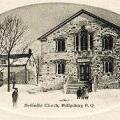 LATER AMERICAN PIONEERS:
LATER AMERICAN PIONEERS:
The vast majority of the early pioneers were not Americans of the Loyalist variety, but immigrants seeking good, cheap land and opportunity.
As Townships historian Cyrus Thomas put it in 1877, they were anything but "martyrs to their political principles, [and] cared as little for royalty as they did for republicanism." Their experience on the American frontier, however, had made them well suited to the harsh pioneer life they would face in the Townships. They brought with them their pioneer spirit of cooperation, self-help, and enterprise.
Large numbers of Americans began to arrive towards the end of the 1790s. Except for a brief interruption during the War of 1812, the influx would continue well into the 1820s, and was largely responsible for the settlement of the southern portion of the Eastern Townships.
The numbers would begin to dwindle only after the completion of the Erie Canal, from Albany to Buffalo, New York in 1825. This new waterway would open up new lands for settlement in the U.S., and most American pioneers, after that time, would prefer to move west instead of into Canada.
The Americans, most of them New Englanders, brought with them their culture, language, customs, agricultural skills, architecture, as well as their numerous Protestant faiths. It was this early wave of immigration, occurring over approximately a thirty year period, that would do so much to shape the Eastern Townships, and whose effects are so evident even today. One has only to look at the American-style clapboard homes that typify the region, the multitude of little Protestant churches that dot the countryside, not to mention the large English-speaking minority that still flourishes in the region to see the legacy of these early settlers.